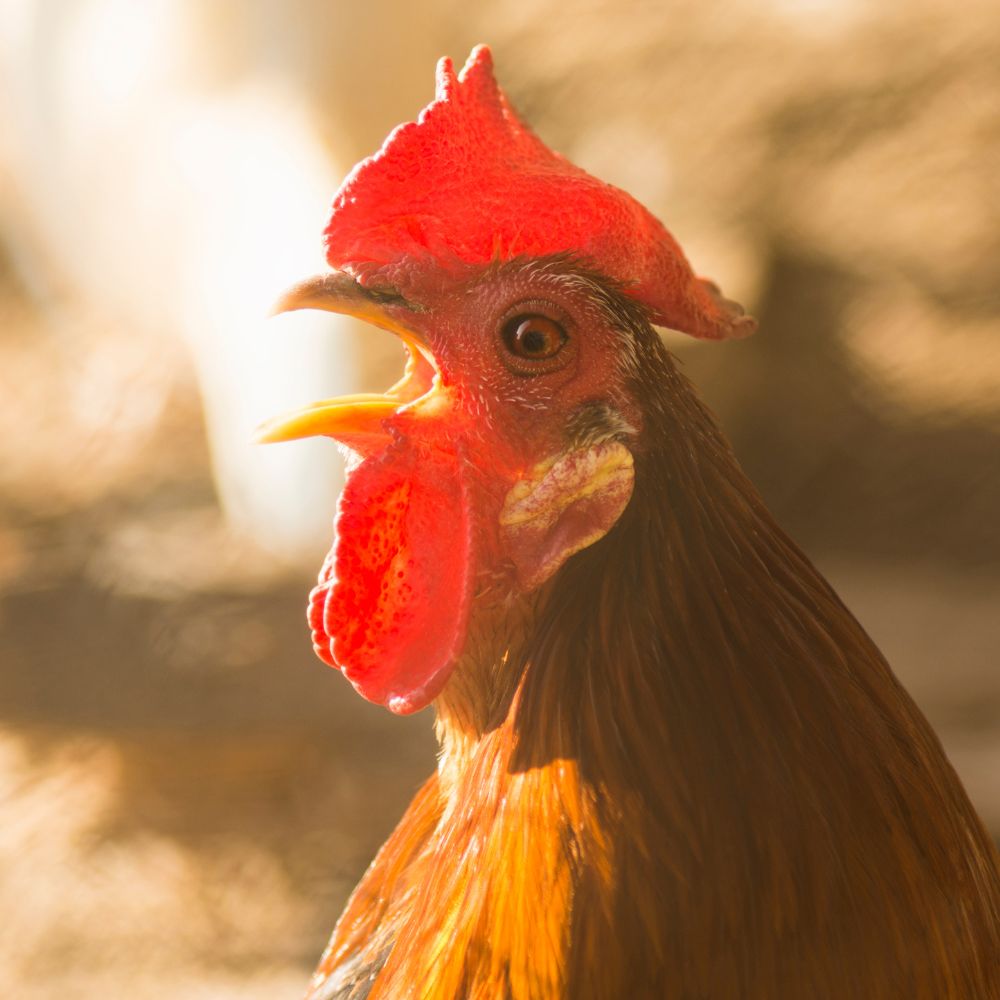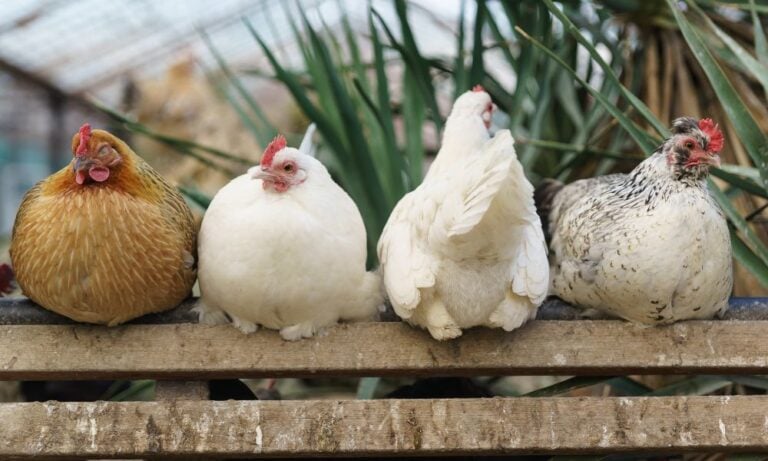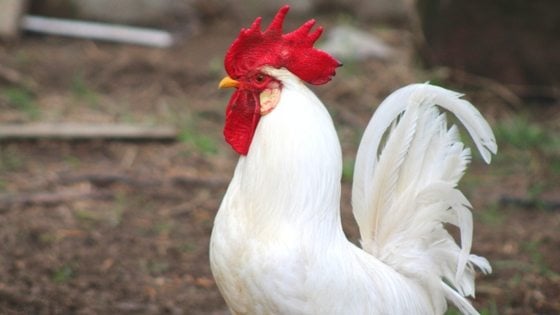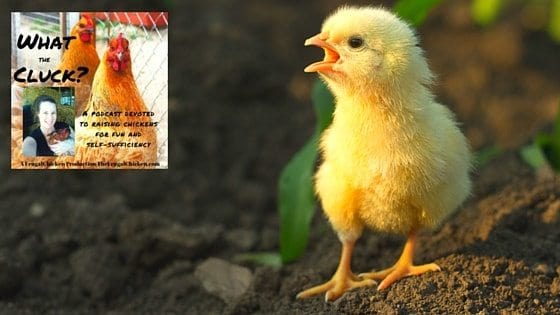We all know chickens have beaks but do chickens have tongues? Well now, maybe you haven’t even thought of that question until reading this! Now, you MUST know!
First, go look inside your chickens mouth…wait, that easier said than done 😆. But we have you covered. Backed by scientific facts and sprinkled with some fun chicken-related trivia, we’ve got the answer to this eggstra fun trivia question.

Table of Contents (Quickly Jump To Information)
The Anatomy of (part) a Chicken
Before we address the question of chicken tongues, we might as well visit the basic anatomy of these birds. Chickens, like other birds, have unique features that suit their needs for pecking, foraging, and consuming their diet of bird delicacies (grains, bugs, seeds, grass, and more).
Let’s start by talking about some of the chicken features we all take for granted.
Beak
First up is the beak. The beak serves multiple functions, such as pecking, probing, and grooming.
Chickens don’t have teeth, which means that chickens cannot chew their food. Instead, they use their beaks to pick up food items and swallow them whole or break them into smaller pieces by grinding the food with a muscular organ called a gizzard.
Combs and Wattles
On top of a chicken’s head, you’ll find the comb and wattles, which are fleshy, red structures. These serve as thermometers, helping chickens regulate their body temperature.
Tongue
Now, let’s address the burning question: do chickens have tongues?
Drum roll please…yes, chickens have tongues! Nothing like a mammals tongue, but a tongue nonetheless.
They do have a very small triangular tonguelike impostor. This tiny little part of the chicken mouth is very hard to see and/or identify. It certainly doesn’t come out of the chickens mouth where we can see it on a regular basis, and there’s no chance your chicken will lick you!
The tongue impostor has a sharp end on it and the rest has a rough texture like that of a cats tongue. This little mystery body part is necessary for poultry to swallow their food.
That being said, I’ll reiterate that it’s nothing like a normal mammal tongue (which is what we usually think of when we say tongue).
Fun Fact: Chickens also have something called a glottis.
A what what? A glottis is in the back of the throat at the base of the tongue. It’s role is gatekeeper – closing when the chicken swallows so the food doesn’t get into the windpipe. Hey, guess what? Humans have this cute little glottis too!
What About the Taste Buds?
While chickens lack a conventional tongue, they do have taste buds. These taste receptors are not located on the tongue but are dispersed along the walls of their mouth and esophagus. The number of taste buds are much lower than that of a human.
Chickens are not known to have a refined sense of taste, and their taste preferences are often geared towards bitter, sour, and sweet flavors. This ability helps them determine which foods are safe and which are not.
Fun Fact: Chickens Taste the Rainbow
Chickens can see a broader spectrum of colors than humans, including ultraviolet light. This ability seems to play a role in their cuisine choices. Some have suggested that chickens use colors to aide in identifying nutritious foods.
So, while chickens may not have tongues in the traditional sense, they have a unique way of experiencing their colorful world.
How Chickens Eat
Now that we’ve clarified the absence of a traditional tongue in chickens, you might wonder how they manage to eat and enjoy their meals. Chickens have been given a clever system for consuming food without the need for chewing.
The Crop
One essential component of the chicken’s digestive system is the crop. This is a specialized pouch located at the base of their neck. The crop acts as a temporary storage chamber for food, allowing chickens to consume food like ninjas and then digest it slowly over time.
Fun Fact: Do Chickens Drink Like A Dog?
No. When chickens drink water they do not lap the water up with their tongues like your family dog. They scoop water up with their beaks. Imagine what a tiny scoop it would be given the size of a chicken’s mouth!
The Gizzard
The gizzard is another very important part of a chicken’s digestive system. It’s a muscular organ that literally grinds food up. Grit, and even small stones, that chickens ingest during pecking accumulate in the gizzard.
The gizzard enables chickens to break down their food effectively without the need for chewing or a traditional tongue.
The Role of the Beak in Eating
The beak plays a crucial role in a chicken’s eating process as well. Chickens use their beaks to pick up food in a very precise manner. If you ever take the time to just sit ond observe a chicken (which I highly recommend), you will be amazed at their pecking abilities.If you do this, toss them some yummy protein rich treats so they can show you their skills.
They can peck at seeds, grass, grains, insects, and other food items with remarkable, award winning accuracy.
Fun Fact: Beak Temperature Control
One fascinating function of a chicken’s beak is its role in regulating body temperature. Chickens don’t have sweat glands, so they can’t sweat to cool down like humans do. In addtion to some of the more commonly thought of temperature regulators, like combs and wattles, they also engage in a behavior called “gular fluttering.”
When a chicken is hot, it may open its beak and rapidly vibrate its throat muscles to promote heat loss through evaporation, somewhat like panting in dogs. This behavior helps them cool down in hot weather.
Chickens’ Communication and Vocalizations
While chickens might not have wagging tongues, they do communicate using various vocalizations. These distinctive sounds are an essential part of their social interactions and can convey a range of messages, from announcing the discovery of food to alerting the flock to potential predators.
Roosters, for example, crow to announce the dawn and establish their territory. Hens may make soothing purring sounds when they are content or loud cackling sounds when they lay an egg. simply put, they make a wide range of noises.
These vocalizations are integral to their flock dynamics and can even help identify individual birds. A very fun read: Uncovering The Mystery – Why Do Roosters Crow?
Fun Fact: Chickens Have Excellent Hearing
Chickens have a keen sense of hearing. They can detect a wide range of sounds, including high-pitched noises that are inaudible to humans. This acute hearing ability helps them stay alert to potential threats in their environment. It also explains why chickens are so hard to sneak up on.
Summary
In the world of backyard chickens and biology, the question of whether chickens have tongues might seem perplexing. The answer is yes they do, but no they aren’t like our tongues.
Will your cantankerous Millie stick her tongue out at you when she’s mad or playful? No. She definitely doesnt’ have that kind of tongue. But do they have a tiny little tonguelike feature that helps them eat? Yes. Yes they do.
Chickens are so cool. They are truly fascinating pets that make the world a better place. And that, my friend, is one of many reasons why we keep chickens!
Want to read more indepth about chicken anatomy, inclduing the tongue? Check out this articlewe came across: A Review of Avian Anatomy
Additional Reading
- Buff Orpington Duck – Feathers Delight
- Infectious Coryza – Respiratory Infections Chicken Foe
- Light Brahma Chicken – Breed of Splendor
- Do Mosquitoes Bite Chickens? 6 All-Natural Remedies To Protect Your Chickens From Pests

A happy wife, mother, teacher, writer, hobby farmer, lover of chickens, and contributor to Pampered Chicken Mama!






